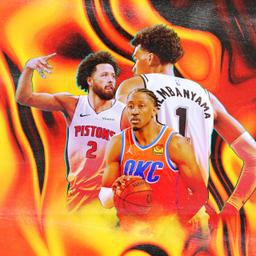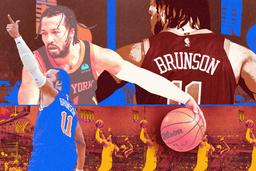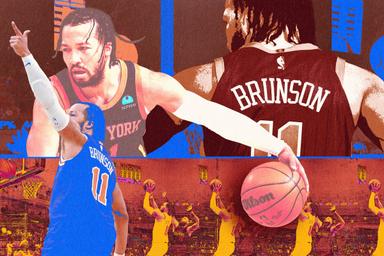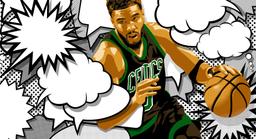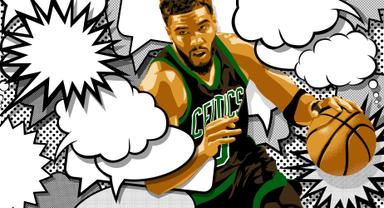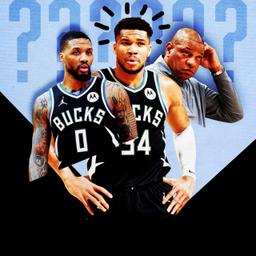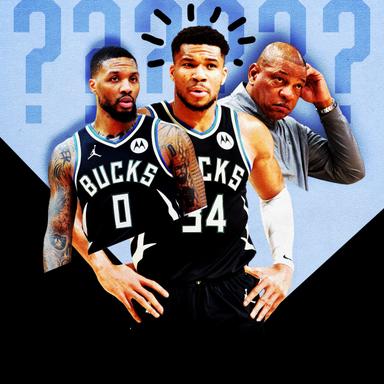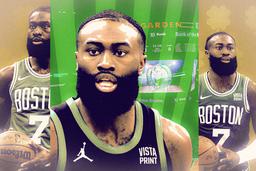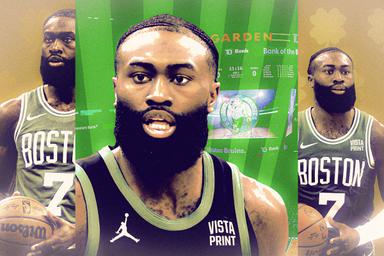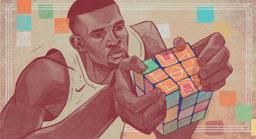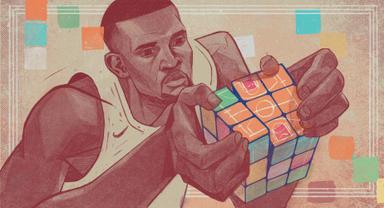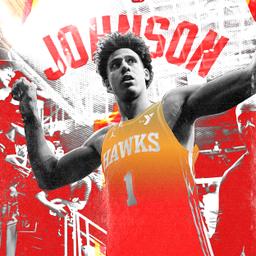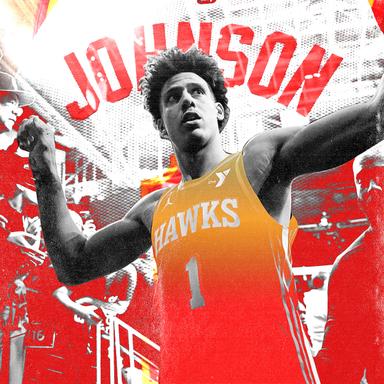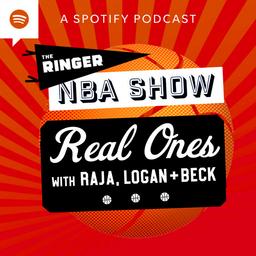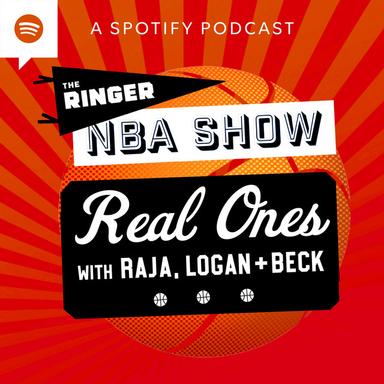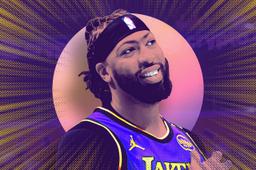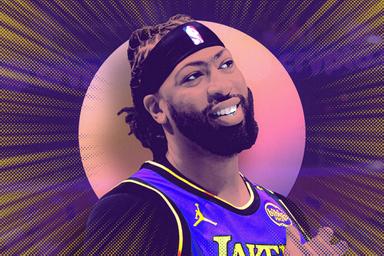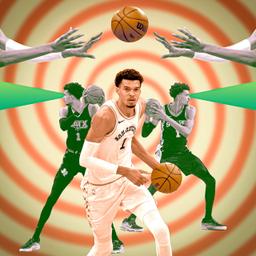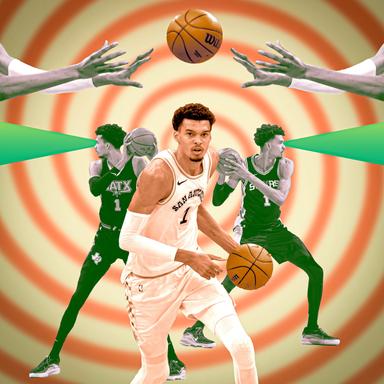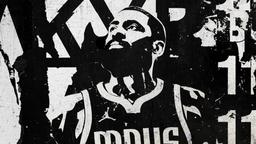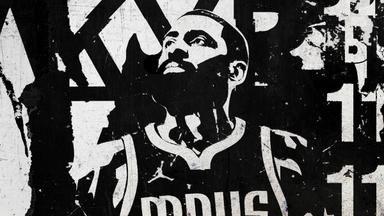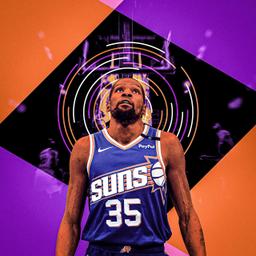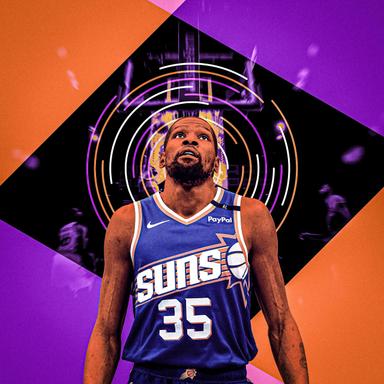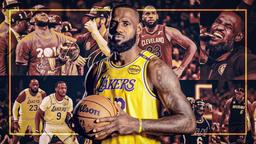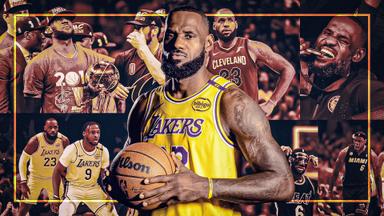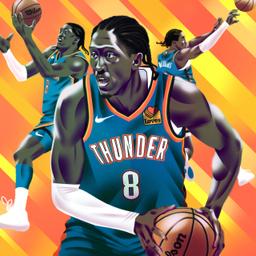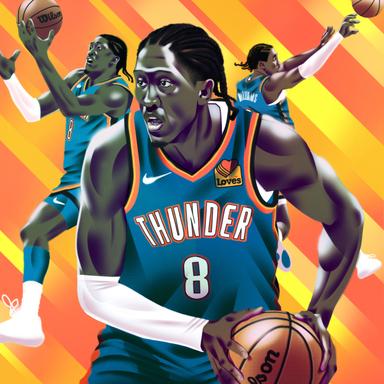By my count, there are at least 35 players who deserve a spot in the NBA’s 2025 All-Star Game. Whittling that pool down to 24 is essentially impossible—akin to specifying your 10 favorite Curb Your Enthusiasm episodes or Stevie Wonder songs. As a new generation of talent rises, the league’s stubborn old guard refuses to recede. “Out with the old, in with the new” would be simple if the old weren’t somehow still doing incredible things without any precedent.
Alas, there are only 24 spots to fill in a process that, for me, is dictated by the following criteria: statistical research, eye-test analysis, and some subjective preferences that aren’t quantifiable. In putting this team together (including the 10 starters who appeared on my official ballot), I care about winning, but the context in which it takes place matters quite a bit. I care about defense, gaudy numbers, and the amount of time each candidate has missed due to injury, too. Certain players gain a millimeter’s worth of leeway over others for reasons that are hard to communicate beyond personal preference.
So, with all that throat-clearing preamble out of the way, and the NBA set to reveal the All-Star Game’s starters this Thursday evening—in a new format that, in my humble opinion, will be short-lived—here are my picks:
Eastern Conference Starters
Backcourt: Donovan Mitchell, Cleveland Cavaliers
Mitchell’s status as the leading scorer on an offensive juggernaut that’s on pace to win well over 60 games is a rubber stamp to San Francisco. It’s fascinating how he got there: Mitchell willingly took a step back this season so that several of his teammates could step forward, resulting in a flourish of two-way dominance that has Cleveland dreaming about another championship.
Putting him in the East’s starting lineup—with so many incredible guards competing for just two backcourt spots—is a reward for his sacrifice as much as for his production. Mitchell is averaging a relatively modest 23.3 points, 4.6 rebounds, and 4.5 assists per game, largely because he’s getting 19.4 fewer touches than last year—the second-largest drop in the league—and his true usage rate is down 4.2 percentage points.
Mitchell is awesome, but for Cleveland to get where it wants to go, this had to happen. His concessions have allowed Evan Mobley and Darius Garland to flourish; what was one of the league’s thinnest playoff teams is now, arguably, the deepest. Mitchell doesn’t overwhelm his team’s system so much as elevate it, leveraging his gravity and attention, taking over when it matters most: In crunch time, his usage rate is 35.0, and his true shooting is 69 percent. This is a no-brainer.
Backcourt: Jalen Brunson, New York Knicks
A few of Brunson’s qualities that are worth admiring: He always plays, he’s never scared, and, to get a bit more specific, he’s one of the NBA’s most effective and expansive pick-and-roll operators, regardless of where his action occurs. According to Sportradar, 36.2 percent of Brunson’s ball screens are set in the middle of the floor, 32.4 percent are on the left side, and 31.3 come from the right. Regardless of which direction he goes from all three of those areas, the result is good offense—if you’re wondering why defenses are so physical with Brunson, it’s partially because he has no obvious weakness to exploit.
Brunson is comfortable getting downhill from any angle. His decisiveness makes slowing him down next to impossible, and he’s incredibly shifty, with hips that swerve like a greasy joystick. He’s masterful at driving away from picks and attacking the space where help defenders don’t expect him to be. Brunson has rejected 23 more screens than anyone else, per Sportradar, while generating 1.3 points per chance (that’s good for the 90th percentile) when he pounces from the midrange.
As someone who ranks 23rd in minutes per game but first in time of possession, Brunson is the engine behind a top-three offense, but, despite that stat, he doesn’t stand around and dribble while his teammates watch. He’s a horsefly off the ball, always moving fast enough to constantly occupy the defense’s attention.
Oh yeah, and, um, not to bury the lede, but Brunson has also scored more points this season than every player in the league except Shai Gilgeous-Alexander. He’s very good at basketball.
Frontcourt: Jayson Tatum, Boston Celtics
As a powerful, unwavering, versatile, increasingly confident superstar who’s coming off a championship season, Tatum is, for what would be the fourth straight year, a virtual lock to make first-team All-NBA. Despite Boston’s recent swoon, he’s still the NBA’s fifth-leading scorer and averaging the most rebounds and assists of his career. Not too shabby.
He’s launching way more 3s than ever before (they now account for more than half of all his field goal attempts) and is knocking down enough tough midrange jumpers to justify the ones he takes. His decision-making is sharp. His responsibility is massive. His physical presence is an advantage the Celtics know how to leverage whenever they need a bucket or a stop.
There are three players who’ve accumulated at least 1,000 points, 300 rebounds, and 200 assists this season: Nikola Jokic, Giannis Antetokounmpo, and Tatum.
Frontcourt: Karl-Anthony Towns, New York Knicks
Watching Towns become the Eastern Conference’s best center shouldn’t surprise those who paid attention to the first nine years of his career out West. The experience, in a sense, has instead been a little maddening. It’s almost like if a prodigious golfer spent their entire childhood hacking through a cow pasture only to flourish once a friend finally invited them to a local country club. Gangly weeds replaced by well-cut fairways.
Nearly a decade of dysfunction—muddled by coaching dismissals, overhauled playbooks, disgruntled and lackluster teammates, front office reorganizations, and one blockbuster trade that made Towns switch his position—preceded what’s on track to easily be the best season of his career. The numbers speak for themselves: 25.1 points and 13.8 rebounds per game and career-high shooting percentages inside and outside the arc. But stats alone don’t fully capture Towns’s impact on the Knicks, who are built to win it all.
When KAT is on the court, New York is a monster truck. He’s finished 11 games with a plus-minus of at least plus-20 this year, trailing just Gilgeous-Alexander and Jokic for the league lead. When Towns is on the court without Brunson, the team’s net rating is still plus-15.8, and the offense generates 125.2 points per 100 possessions. He uses his outside shot to open the floor as well as any big can, whether he’s trailing in transition, spotting up in the half court, popping off a ball screen, or coming off a pick. Towns doesn’t need to touch the ball to make life easier for everyone around him.
But now that he’s surrounded by more offensive talent than ever before, when he does find himself in position to score, Towns can go to work without needing to worry as much about help defenders. According to Sportradar, Towns has been double-teamed on 19.0 percent of his post-ups this year. Last season that number was 29.9 percent. Opponents that leave him on an island are paying a steep price. He’s a nimble powerhouse on the block, perfectly capable of doing damage with either hand:
He’s always been awesome when driving the ball from the perimeter, getting his man to bite on a pump fake, and then taking off for the rim. With the Knicks, though, his effectiveness has been startling. There are 85 players who’ve driven the ball at least 200 times this season, but none of them average more than KAT’s 1.191 points per chance.
He still occasionally commits harebrained fouls, and some of the defensive concerns that were a waving red flag early in the season remain. He’ll never be Rudy Gobert in drop coverage. But Towns has been better on that end over the past couple of months. Since December 1, opponents are shooting just 62.4 percent at the rim when he’s nearby contesting the shot, per Sportradar. Before that, it was 77.9 percent. The remnants of concern about how KAT’s second stint with Tom Thibodeau would go no longer exist. So far, everyone in New York couldn’t be happier with how this preseason trade is going.
Frontcourt: Giannis Antetokounmpo, Milwaukee Bucks
The Bucks have been a shaky team this season, but Antetokounmpo has never let them crash. He’s averaging 31.5 points, 12 rebounds, 6 assists, and 1.4 blocks per game and leads the NBA in fast-break points and points in the paint.
His league-best 140 dunks are 25 more than anyone else’s, and, remarkably, almost half are unassisted. There’s simply no one who physically dominates basketball games like Giannis. But this year he’s also (so far) added a respectable jumper to the repertoire, with 13.5 percent of his points coming from the midrange (up from 5.5 percent a season ago). What’s even more relevant than the increased volume is how opponents are dealing with it.
Presumably, most defenders would prefer to sag back and pray for a pull-up. Some do. But a staggering 57.9 percent of Antetokounmpo’s 2-point shots taken outside the paint are contested, per Sportradar, a number bested by only DeMar DeRozan. (Last year, Giannis was at 38.7 percent.) He’s also averaging about twice as many of these shots as DeRozan and is a bit more accurate. Truly wild stuff.
His two-man game with Damian Lillard deserves some love, too. Of late, they’ve started to perfect what’s now a devastatingly reliable empty-corner pick-and-roll that’s now manufacturing 1.47 points per chance, according to Sportradar. Most opponents simply have no logistical answer for someone who, despite being unstoppable in transition and a sharp-shouldered bulldozer on the block, just might be at his most terrifying the moment before he catches a pass.
Anyway, it’s hard to come up with new things to say about this guy. He’s on pace to make first-team All-NBA for the seventh straight season. There aren’t a dozen players in the history of the league who can say that. And even if the Bucks still might not be a true title contender, they don’t look anything like the disaster they were in November. They have Antetokounmpo to thank for that.
Eastern Conference Reserves
Backcourt: Cade Cunningham, Detroit Pistons
Now that the starting five is spoken for, there are technically four open spots remaining for about eight guards who deserve an invitation. The margins separating them are subjective, but Cunningham has become a lock.
Being surrounded by actual shooters for the first time in his career helps. (No player has assisted more 3s this season.) Steering lineups that don’t look like they were cryogenically frozen in 1988 does, too. Cunningham’s ceiling, as a former no. 1 pick, is starting to look like a (slightly smaller) cross between Luka Doncic and Jayson Tatum. There’s offensive versatility, three-level scoring, plus defense, and complete command of the pick-and-roll.
Cunningham has never looked so comfortable. Only Trae Young and Brunson have the ball in their hands more often. Only Young and Jokic are averaging more assists. His impact on Detroit’s half-court offense is elite. He ranked 192nd in estimated plus-minus last year and is now near the top 25.
His 3-point shot is coming around, and he’s already established himself as one of the league’s top playmakers. Cunningham would be a top-10 player if he could just cut down on some of the more negligent turnovers and finish at the rim like someone his size, with his touch, should.
This has nothing to do with on-court production, but I also just love how much of a leader Cunningham has become. You can see his love for and trust in his teammates, which is constantly reciprocated. Look at this sequence from Detroit’s New Year’s Day win in Orlando. Cunningham spends damn near an entire possession clapping for Isaiah Stewart after he switches onto Jalen Suggs:
This is what an ideal franchise cornerstone looks like: someone who infuses confidence in everyone who depends on them. The Pistons are a playoff team right now; no individual is more responsible than Cade.
Backcourt: Darius Garland, Cleveland Cavaliers
Sometimes I watch the 36-6 Cavaliers and wonder who their best guard really is. The correct answer is Mitchell. But the fact that it’s even a somewhat reasonable debate—after these two searched for a more compatible coexistence over the past two seasons—is staggering.
Garland has 50/40/90 shooting splits and ranks third in the entire league in offensive estimated plus-minus. (The two players ahead of him are Jokic and SGA.) He’s slippery off the bounce and has a parlor trick floater that goes in 64.7 percent of the time, a diabolical number. On some of his drives, he looks like he’s wearing Rollerblades against people who are just learning to walk:
Garland isn’t better than Mitchell, but the gap between them is narrower than most realize. When Garland’s on the court, Cleveland’s half-court offense scores 111.3 points per 100 plays, which is 11.8 points better than when he sits. Those two numbers rank in the 100th and 98th percentiles, respectively, at his position. Leaguewide, nobody who’s appeared in at least 10 games has a higher offensive rating.
His crunch-time splits are downright stupid: 78.8 true shooting percentage and a 33.3 usage rate. Again, stupid. Don’t be surprised if Garland receives some Most Improved Player votes. The leap he’s made this season has been absolutely critical for Cleveland’s climb into the true contender tier.
Frontcourt: Pascal Siakam, Indiana Pacers
Has this quietly been the best season of Siakam’s career? I say “quietly” because whenever I hear people talk about frontcourt All-Star candidates in the East, his name never comes up. But it should! Siakam isn’t the most aesthetically pleasing scorer you’ll ever watch, but he’s the fail-safe that Indiana’s offense often needs; he’s averaging 20.1 points and 7.3 rebounds per game while making over 40 percent of his 3s, and he has the lowest turnover rate in the league (minimum 30 minutes per game).
Siakam has been a matchup nightmare with his back to the basket all year. (Only Jokic, Alperen Sengun, and Victor Wembanyama have logged more post-ups this season, and Siakam ranks first in points over expectation.) He has so much awkward guile (that’s a compliment!), resilience, and artifice. Siakam can score from anywhere, but his office is the right block. According to Sportradar, he generates a whopping 1.31 points per chance on those plays. No matter how prepared the defender is for what’s coming, Pascal has a counter:
Tyrese Haliburton is functionally Indiana’s most important building block, but through the first few months of this season, Siakam, the guy they traded for so that everyone else would take them seriously, has been its best player.
Frontcourt: Jaylen Brown, Boston Celtics
Coming off a Finals MVP, Brown’s production has only gone up. His assist rate has never been higher, he’s never attempted more free throws, and he’s handling tough on-ball defensive assignments as the second-best player on the East’s second-best team. Boston’s offense is known for 3s, but it’s founded, partially, on Brown’s ability to capitalize one-on-one when the defense surrenders a mismatch.
There might not be a more pronounced combination of power, craft, and explosiveness in the entire league, features that really pop when Boston is shorthanded in transition. The Celtics generate 14.8 more points per 100 transition plays with Brown on the floor (a mark that’s in the 91st percentile), and according to Sportradar, the only player who’s finished more possessions with a four-on-five disadvantage after the ball crossed half court is Jaren Jackson Jr.
But it hasn’t been all roses this season. Brown is also having a disappointing year shooting the ball. His 3-point percentage is down to 32.0 percent (55th out of 57 players who take at least six attempts per game), and he is under 40 percent from the midrange, which hasn’t happened since his second year. Still, even during their recent lull, the Celtics have largely dominated with Brown on the court, and their offensive rating when he’s on the court without Tatum is still better than when Tatum is on the court without Brown. The shooting numbers seem more like an inexplicable aberration than a permanent shift, but they are definitely worth monitoring over the next few months.
Frontcourt: Evan Mobley, Cleveland Cavaliers
Mobley is clearly better than he was a couple of years ago, when his All-Star potential first emerged, but I wouldn’t characterize this fourth season as a “breakout,” per se. To me, it seems like Cleveland has acknowledged his value and acutely realized that he needed to be emboldened—i.e., put in more spots where teammates complement him rather than the other way around—before Cleveland could unlock its true potential.
He’s upped his 3-point volume a smidge (from 1.2 to 2.8 attempts per game) and is making a career-best 42.1 percent of them. That’s helpful but was never the be-all, end-all some built it up to be. Mobley could still be a great two-way player without an outside shot, whether beside another non-shooting center or alone at the 5.
To become an All-Star, he had to enhance everything he was already pretty good at—a progression accelerated by Kenny Atkinson’s vision and Mitchell’s aforementioned sacrifice. The upshot speaks for itself. Without taking anything away from his defense, Mobley has been more emphatic in just about every area that matters when Cleveland has the ball. The result? More efficient shots for everybody else.
Since Mitchell arrived two years ago, Mobley is the only Cavaliers starter who’s seen his true usage rate increase, per Bball-Index. Over the past two years, he finished 90 plays as a pick-and-roll ball handler, total. This season he’s already run 89. Good things happen when he does.
When he grabs a defensive rebound and pushes it up the court, he’s now keeping his dribble alive with a take-no-prisoners mentality. Here’s what that looks like, the type of sequence that rarely happened last year but now appears in bold type on scouting reports across the league:
The Cavaliers obliterate everything in their way when Mobley plays power forward and, um, obliterate everything even harder when he’s their lone big. The latter lineups are particularly successful on defense. Atkinson has taken this unusually agile big man and asked him to switch even more screens than before. It’s worked well enough to assure that he’ll be in the conversation for Defensive Player of the Year (Non-Wemby Division) for the second time in three years. The scariest part is that he still has so much time and space to grow. Don’t be surprised if Mobley is in the MVP conversation a few years from now.
Wild Card: Trae Young, Atlanta Hawks
Tallying 86 more assists than anyone else before the All-Star break is definitely not easy. Neither is tallying 190 more potential assists than any other player. To do either with several new teammates and one of the youngest rotations in the NBA, while leading an above-.500 team that entered the season somewhere between a total rebuild and a delicate remodeling, is kind of absurd.
Every pass is in Young’s bag: the paper towel lobs, corner skips, bouncing dimes in the pocket, touchdown throw-aheads, and anything else his imagination is able to conjure on the fly. His assists generate a whopping 29.0 points per game, which leads the league.
Trae has the second-highest true usage rate in the NBA and runs the most pick-and-rolls. He’s especially potent on single-side actions—where one teammate is in the corner and two others are positioned on the opposite side. It’s not abnormal to see full-blown genius on display when Young comes off a ball screen and his screener rolls downhill. The defense is compromised in these spots, so absent a solution that they eventually resort to full-on panic, throwing two defenders on Trae and merely hoping that his teammates don’t make them pay.
Yes, Young’s efficiency doesn’t come close to what we’ve seen from Tyler Herro or Lillard; his shooting splits are down and his floater hasn’t been as accurate this season compared to years past. But in the context of this much offensive responsibility and a remade supporting cast, some of Trae’s down shooting can be forgiven on a team that offers such little room to operate.
Among players to log 1,000 minutes this season, only six have a more positive impact on their team’s half-court offense, per Cleaning the Glass. He’s drilled the third-most pull-up 3s in the league, nosebleeders from 30 feet that are typically delivered in backbreaking fashion and remind whoever’s guarding him that within the flow of a game, some players’ shooting percentages are less important than others’.
For all his warts—an excess of bad-pass turnovers and woeful defense, to name a few—please don’t forget where we started. This level of playmaking is special! The only players in NBA history to have averaged more assists than Young is right now are John Stockton, Magic Johnson, Isiah Thomas, Kevin Porter, and Kevin Johnson. Nobody has dished out 12 per game this century; Trae is currently at 11.7.
Wild Card: Jalen Johnson, Atlanta Hawks
I don’t mind the Hawks, a middling play-in team, having two All-Stars, and it’s hard to compare (positively or negatively) Johnson’s production this season against a slew of worthy backcourt candidates who are also qualified. But as a multipronged, truly positionless athlete who bruises like a big and sees the floor like a point guard, Johnson belongs. His 19.4 points, 10.3 rebounds, 5.2 assists, 1.4 steals, and 1.1 blocks per game are rare, a sweeping amount of production that doesn’t fully illustrate all the ways he helps Atlanta win.
The Hawks are plenty respectable when Johnson is on the court: They’re 7-2 against the Celtics, Cavaliers, and Knicks. When he sits or misses games, they fall off a cliff. Up until last week, his net point differential ranked below only that of Jokic, Gilgeous-Alexander, and Wembanyama. Last month, I wrote a feature about all the ways his selfless tendencies make everything easier for those around him (the true sign of a star). He’s sixth in the whole league in touches and averages the third-most passes per game. He can stand to be more efficient and commit fewer turnovers, but as someone who impacts winning while creating so few holes for the opponent to pick at and so many different mismatches he can take advantage of, Johnson gets this last spot by a hair.
Last cut: Damian Lillard, Milwaukee Bucks
Lillard’s numbers are phenomenal. His chemistry with Giannis is getting better and better (those empty-corner pick-and-rolls are becoming a problem.) But I kept coming back to how detrimental his defense is and how bad the Bucks are when he’s on the court without Antetokounmpo.
Honorable mentions (in alphabetical order): Bam Adebayo, Jarrett Allen, LaMelo Ball, Tyrese Haliburton, Tyler Herro, Zach LaVine, Tyrese Maxey
Western Conference Starters
Backcourt: Shai Gilgeous-Alexander, Oklahoma City Thunder
Even if every NBA star had perfect health, SGA would still be a main character in any debate about the second-best player alive. So much of what he does on a basketball court is unapproachably smooth and practical and has a general degree of difficulty that isn’t fair. As the odds-on favorite to win MVP, the man has scored over 74 more points on unassisted 2-point shots than anybody else. That’s incredible.
Much like James Harden in his prime, once SGA is in a triple-threat position, there’s no keeping him from wherever he wants to go. He’s too random, elusive, and idiosyncratic. Any attempt to contain him must feel like catching raindrops with a tennis racket.
Gilgeous-Alexander makes the impossible look easy. Do you realize how feared a midrange shooter must be in today’s NBA to get their defender to bite on a pump fake? The ability to lift someone off their feet inside the arc but outside the restricted area is, increasingly, a lost art; SGA is one of the few connoisseurs still doing it:
He makes a league-high 7.2 free throws per game, and he's the most accurate of the 52 players who've taken at least 65 jumpers from the midrange this season.
Zooming out into historically relevant territory, Shai is on pace to average more than 30 points per game for the third straight year. The only guards who’ve ever done that are Oscar Robertson, Michael Jordan, and Harden. That’s it. That’s the list. It’s no surprise to see him lead the fan vote at his position. No guard deserves it more.
Backcourt: Anthony Edwards, Minnesota Timberwolves
It’s been an electrifying and erratic few months for Edwards. There are nights when last season’s euphoric playoff run to the Western Conference finals seems like it was 35 years ago (remember all those comparisons to MJ?). And there are nights when Edwards puts a feat of athleticism on display that can’t be achieved by 99.99999999999999 percent of the human race.
Since Julius Randle replaced Towns, Father Time finally caught up to Mike Conley, and Rudy Gobert continued to be Rudy Gobert, Edwards’s shot chart has been a victim of its own circumstances. Minnesota’s spacing has not been ideal, and its offense has stumbled through some frustrating lulls, particularly in the fourth quarter. Edwards has made a season-high 28 crunch-time appearances. In them, he’s had just six assists and nine turnovers and ranks dead least out of 398 players in plus-minus. Yikes. (Unrelated but also not ideal: He’s been fined a total of $285,000 this season for in-game and postgame conduct that was deemed unseemly by the NBA.)
But there have also been some encouraging developments. Edwards has fallen in love with the 3-point line for reasons that are both logical and, thanks to those aforementioned spacing issues, a little forced. But if you’re going to lead the entire NBA in 3-point attempts and rank 12th in 3-point accuracy, well, right on! This improvement should not be taken for granted. Coming into this season, Edwards was right around league average from deep. Now, All-Star Weekend can’t hold a serious 3-point contest without him.
He’s taking 7.1 pull-up 3s per game and drilling 43.1 percent of them. Put another way, there are 65 players who average at least two pull-up 3 attempts per game, and Edwards is the fourth-most accurate. He’s uncanny. And in the spirit of not overthinking things, when you combine that outside shot with the quickest first step in the league and some of the springiest legs ever seen, you get plays like this:
Edwards has flaws, and his team doesn’t come close to accentuating his greatest strengths. But sometimes the disappointment surrounding his season seems like it blots out everything that makes him a showstopping one-of-one nightmare. The phrase “unstoppable” applies to only a handful of NBA superstars, and Edwards is firmly in that club.
Frontcourt: Anthony Davis, Los Angeles Lakers
It’s easy to take Davis for granted. He could’ve been one of the greatest big men ever, so people pick apart everything he doesn’t do with a “waiting for the other shoe to drop” pessimism thanks to all the injuries he’s suffered.
But he’s missed only three games this season, and the All-NBA-caliber big man is doing all he can for the Lakers, who have no business being a 6-seed in the Western Conference. (They rank first in win differential, with 4.3 more wins than their net rating suggests they should have.) This hasn’t been AD’s best defensive season by a mile—in no small part thanks to the suspect scheme he’s sometimes had to play in and the teammates he’s had to protect—but he is still so damn important on that end, whether on the ball, rebounding, or protecting the paint.
He’s also fourth overall in PER, 12th in points, sixth in rebounds, third in blocks, fourth in 2-point baskets, and fourth in free throws. Not bad.
Frontcourt: Victor Wembanyama, San Antonio Spurs
Watching the last 30 minutes of Alien: Romulus might be the closest most people can get to understanding what it’s like to compete against Wembanyama. In addition to having a tentacle-armed resemblance to that movie’s final boss, Wemby brings a similar claustrophobic dread every time he steps on the court. The nature of his domination right now makes it almost impossible to process what you are seeing in real time.
Wembanyama just turned 21 and is already one of the half-dozen best players in the world. Since December 1, on a Spurs team that’s winning more games than most expected, he’s averaging 25.3 points, 11.4 rebounds, 4.2 assists, and 4.4 blocks per game. He ranks fourth in estimated plus-minus, exudes more confidence on (and off) the court than many multiple-time All-Stars, and performs at least one highlight in every game that has never before been done.
He’s also the best defender alive and maybe a year or two from entering the debate about the greatest rim protectors who’ve ever lived (look at how he stacks up against other shot blockers before they turned 22). Opponents are currently shooting a minuscule 47.3 percent at the rim on shots he’s close enough to contest, which is first out of 87 players who’ve combated at least 100 shots, per Sportradar. (This obviously doesn’t even count the significant number of shots he discourages from happening at all.)
All told: San Antonio’s rebuild is over. Victor killed it. Even if the Spurs don’t make the play-in this season, Wemby’s already too good for them to be patient and construct a championship roster through the draft. What comes next is anyone’s guess, but step one is starting in his first All-Star game a few weeks from now.
Frontcourt: Nikola Jokic, Denver Nuggets
A couple of years ago, Bruce Brown gave me this quote about Jokic that still just about sums up his singular skill set: “He’s like a guard in a big man’s body and he can do big man shit.” When Brown said that, Jokic wasn’t the most accurate 3-point shooter in the NBA (which he’s been for most of this season). He didn’t average the third-most points, third-most rebounds, and second-most assists in the entire league. The Nuggets have never been this good with Jokic on the court, and they’ve never been this bad without him. Not to outdo Brown, but another way to illustrate Jokic’s greatness in a single sentence might go something like this: He’s the world’s best player, having the best season of his career.
Western Conference Reserves
Backcourt: Steph Curry, Golden State Warriors
The margin that kept Curry out of my starting five was paper thin. It essentially came down to a pair of tiebreakers: minutes and standings. Edwards has played more than 500 more minutes than Curry, and his Timberwolves were two spots above the 11th-seeded Warriors.
Neither variable is Curry’s fault, of course. He can’t help being 13 years older than Ant, and his impact, in some ways, has never been more noticeable. The Warriors offense is 17.3 points per 100 possessions better with Curry on the court. Their effective field goal percentage is 9.5 percentage points higher, too. Both rank in the 100th percentile. He’s making the most 3s per possession and attracts more attention when he’s off the ball than any player in league history. The Warriors are an abomination for several reasons. Maybe the biggest is their inability to play Curry 48 minutes in every game.
Backcourt: Kyrie Irving, Dallas Mavericks
The competition here is loaded, with Devin Booker, De’Aaron Fox, and the insatiable Norm Powell to consider. To be honest, I have no objective reason for picking Irving. The statistical case for these candidates is nearly identical. All merit an All-Star appearance. Irving might just have the fewest snags. His 3-point percentage is a career high and he’s making over half of his 2-point shots.
What really stands out is his impact in the fourth quarter. There are 259 players who’ve appeared in at least 20 fourth quarters this season. Only two players have a higher offensive rating than the 130.5 Dallas generates with Irving on the court. His baskets remain as inevitable as they are breathtaking, often preceded by some puzzle-box dribbling exhibition or incomprehensible decision executed perfectly in midair.
If I’m being honest, it also just felt weird not picking any All-Stars from a team that’s good enough to reach the NBA Finals, and Doncic has missed too much time to make it.
Frontcourt: Kevin Durant, Phoenix Suns
I recently wrote a piece explaining why the Suns need to trade Durant. It had zero to do with how ridiculously skilled and productive he still is despite some of the restrictions clamped on by the deeply mismanaged roster Phoenix has built around him and Devin Booker.
KD is still double-teamed constantly. Running him off a pindown remains one of the most effective actions a basketball team can run. It’s kinda shocking when he lets go of a basketball and it doesn’t go exactly where he intended. (In losses, Durant is averaging 30.3 points with a 65.7 true shooting percentage.)
If there’s any hang-up—beyond the unsurprising age-related decline that keeps him from bringing it every night on both ends with the same force we saw five years ago—it’s his 3-point rate. Mike Budenholzer was ostensibly hired to modernize Phoenix’s shot selection, which should translate to more outside shots for one of the game’s deadliest outside shooters.
Instead, Durant’s 3-point rate has been static and his team still dines out on more long 2s than it should. In the context of an individual All-Star case, though, that’s a footnote. KD, at 36 years old, ranks sixth in scoring, can still get to his spots, and still doesn’t even see whoever’s guarding him as he rises to shoot. There are no answers when he has it going.
Frontcourt: LeBron James, Los Angeles Lakers
It’s hard to watch a 40-year-old LeBron and not see obvious signs of physical decline. He doesn’t get to the rim as often as he used to or bring the same amount of energy on defense every night. For the first time in his career, LeBron’s team has been getting outscored when he’s on the court and has been significantly better when he’s on the bench. Most of the downshift is understandable, if not expected. James has played more NBA basketball than anyone who’s ever lived. (His son is on the team!) Comparing who he is now to what he used to be is a tempting way to conduct this exercise, but it’s also misguided. When likened to every other active star, LeBron holds up pretty well.
He has a top-15 PER, top-50 true shooting percentage, and top-five assist rate. Only Jokic has more triple-doubles, and only Jokic brings a similar on-court intellect to every possession. To make up for legs that aren’t as quick as they used to be—but still pretty damn fast—LeBron is the anticipation king. He knows when to drive, when to pull up, when to hit an open teammate, and, using a mental timer that’s been perfected over the past two decades, when to catch help defenders in a compromised position.
Cut and he will find you. Give him space and he will probably score. Here’s an example where LeBron doesn’t go to the rim until he knows Pistons center Jalen Duren is inching his way outside the paint, toward AD at the free throw line.
His post-ups still demand a double-team and precisely zero NBA players know how to/are brave enough to stop him in transition. This man could probably play until he was 45 if he wanted to.
Frontcourt: Domantas Sabonis, Sacramento Kings
I’m not sure exactly why Sabonis gets overlooked in All-Star conversations. Maybe there’s something about his repetitive, undeviating production that doesn’t get too high or too low. Maybe it’s the subtle contributions—he leads the league in screen assists by a significant margin!—or the fact that his defensive limitations seemingly place a hard ceiling on his team’s ability to win at the highest level.
Who knows? Regardless, he’s been one of the NBA’s most valuable and consistent players on a team that fired its head coach last month after adding DeMar DeRozan to the fold in July. In an extremely competitive pool of frontcourt reserves, Sabonis is the closest thing to a lock. His numbers are wild: 20.8 points, a league-high 14.2 rebounds, and 6.3 assists per game. Only four players have a higher true shooting percentage, only three players are above him in win shares, and zero players have a higher 3-point percentage.
The case against Sabonis basically boils down to “his team is .500,” which, well, they might be the worst team in the Western Conference without him. When he plays—whether De’Aaron Fox is on the court or not—the Kings are pretty good. He’s ninth in estimated plus-minus and fourth in estimated wins (behind Jokic, SGA, and Tatum).
Wild Card: Alperen Sengun, Houston Rockets
The per-game numbers are worthy: 19.2 points, 10.5 rebounds, 5.1 assists. The efficiency is not: His true shooting percentage is 54.0 (below the 57.4 percent league average) on a diet of contested floaters, fallaways, and wide-open 3s that rarely go in). But Sengun’s overall production and defensive improvement are two humongous reasons Houston has the second-best record in a loaded Western Conference. (It’s also 12-4 against teams with a top-10 net rating, with the league’s fifth-best offense in those games.)
Sengun is his team’s leader in rebounds, plus-minus, field goals, PER, win shares, usage percentage, and assist rate. He’s also second in points and touches. In the whole league, Sengun ranks third in the percentage of non-shooting fouls he draws per play, which helps explain why the Rockets spend 27.2 percent of their minutes in the bonus, a number that’s behind only the Memphis Grizzlies. And if Jokic didn’t exist, Sengun would lead all centers in potential assists.
Most importantly, he’s completed a shocking turn from defensive liability to mobile rim protector. The evolution has mostly come as a help defender, roaming off of non-shooters away from the offense’s primary action. But he’s also become more solid guarding pick-and-rolls, backpedaling in a drop while keeping both the ball and the screener in front of him. In a recent loss against the Kings, his defense was primarily responsible for a 10-0 run in crunch time that nearly won Houston the game. It’s remarkable growth from a center who’s still somehow only 22 years old.
Wild Card: Jaren Jackson Jr., Memphis Grizzlies
Most of Jackson’s numbers mirror his production from two seasons ago, when he made his first and only All-Star team (and won Defensive Player of the Year). But there’s a big difference in how he’s now doing it. In 2022-23, 59.5 percent of Jackson’s field goals were assisted. Today it’s a career-low 44.0 percent. (And a microscopic 29 percent at the rim when he’s at power forward.) JJJ habitually making tough, contested shots without any direct setup is one of the many reasons Memphis should see itself as a legitimate title contender. It’s fair to argue that no star-caliber player has made a more meaningful improvement in their game this season.
On driving floaters (of which he’s launched the third most in the league, and quite possibly more than every other big man combined), Jackson is shooting 56.3 percent. The footwork, touch, and strength, whether finishing with his strong or off hand, has been a critical cog in Memphis’s unmethodically specific offense. Contact doesn’t bother him as much as it used to:
All this is happening for someone who’s virtually guaranteed to make another All-Defensive team. When Jackson contests a shot at the rim, opposing field goal percentages are 16.3 percentage points lower than their average—first among all players who’ve logged at least 500 minutes. He also ranks very, very high in a stat I just made up called Wow, That Guy Just Single-Handedly Blew Up the Other Team's Entire Possession:
He still fouls a bit too often, but that hasn’t stopped him from ranking 10th overall in estimated plus-minus. Few players have a larger effect on their team’s success than him.
Last cut: Jalen Williams, Oklahoma City Thunder
This was by far my toughest snub. JDub rules and does virtually nothing wrong. Even as I write this sentence part of me wants to swap him in as a wild card! (I blame antiquated positional designations: Williams would be on the team if he qualified for a spot in the backcourt.) But in the end, the two who did make it are ever so slightly more valuable to their respective (very good) teams. Not only has Williams been way less efficient than he was last season, but the Thunder have been significantly better when he’s on the bench this season. A lot of that isn’t his fault, but not everyone can make it!
Honorable mentions (in alphabetical order): Devin Booker, Luka Doncic, De’Aaron Fox, James Harden, Ja Morant, Norm Powell
